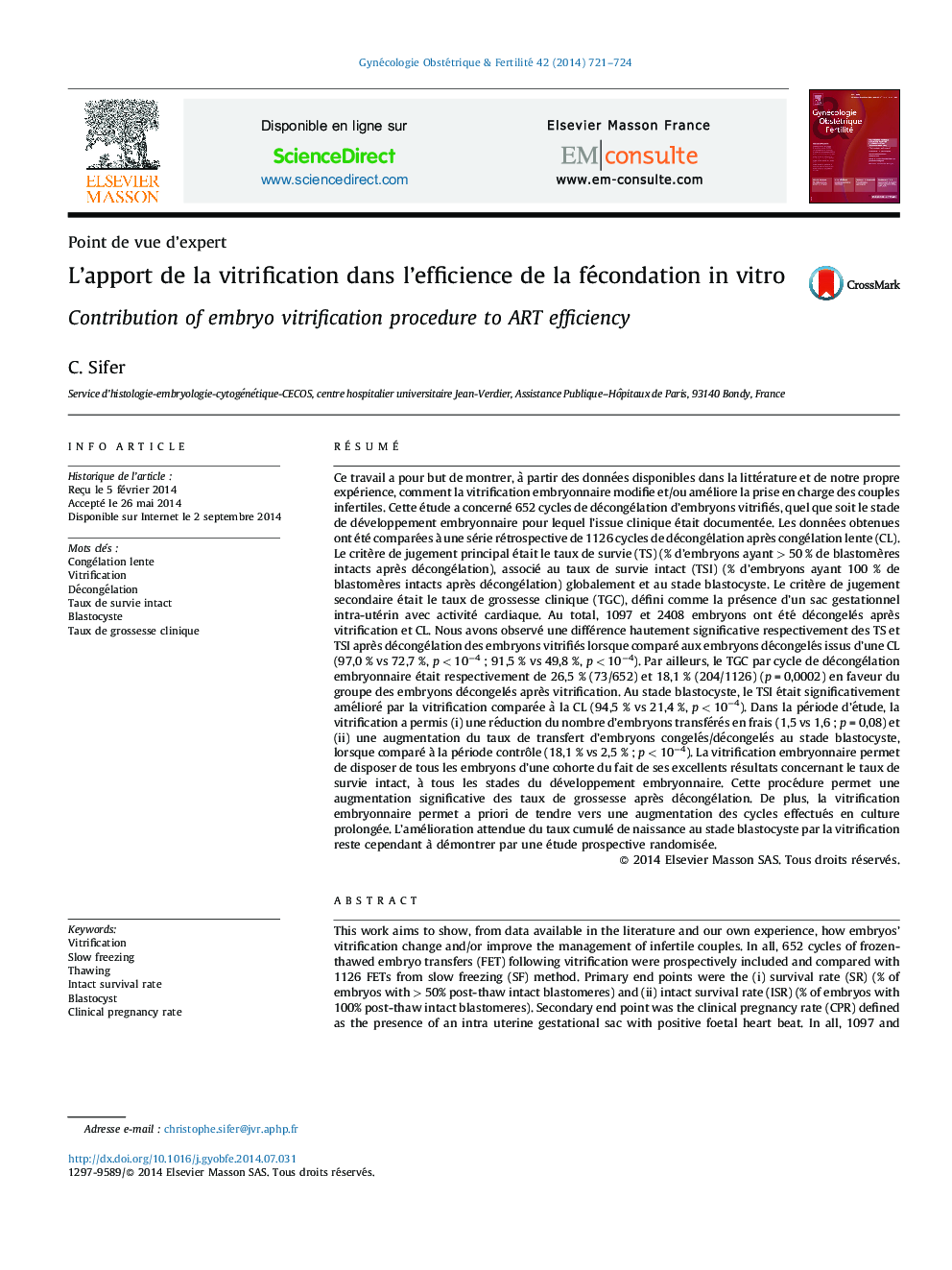| کد مقاله | کد نشریه | سال انتشار | مقاله انگلیسی | نسخه تمام متن |
|---|---|---|---|---|
| 3951440 | 1254864 | 2014 | 4 صفحه PDF | دانلود رایگان |

RésuméCe travail a pour but de montrer, à partir des données disponibles dans la littérature et de notre propre expérience, comment la vitrification embryonnaire modifie et/ou améliore la prise en charge des couples infertiles. Cette étude a concerné 652 cycles de décongélation d’embryons vitrifiés, quel que soit le stade de développement embryonnaire pour lequel l’issue clinique était documentée. Les données obtenues ont été comparées à une série rétrospective de 1126 cycles de décongélation après congélation lente (CL). Le critère de jugement principal était le taux de survie (TS) (% d’embryons ayant > 50 % de blastomères intacts après décongélation), associé au taux de survie intact (TSI) (% d’embryons ayant 100 % de blastomères intacts après décongélation) globalement et au stade blastocyste. Le critère de jugement secondaire était le taux de grossesse clinique (TGC), défini comme la présence d’un sac gestationnel intra-utérin avec activité cardiaque. Au total, 1097 et 2408 embryons ont été décongelés après vitrification et CL. Nous avons observé une différence hautement significative respectivement des TS et TSI après décongélation des embryons vitrifiés lorsque comparé aux embryons décongelés issus d’une CL (97,0 % vs 72,7 %, p < 10−4 ; 91,5 % vs 49,8 %, p < 10−4). Par ailleurs, le TGC par cycle de décongélation embryonnaire était respectivement de 26,5 % (73/652) et 18,1 % (204/1126) (p = 0,0002) en faveur du groupe des embryons décongelés après vitrification. Au stade blastocyste, le TSI était significativement amélioré par la vitrification comparée à la CL (94,5 % vs 21,4 %, p < 10−4). Dans la période d’étude, la vitrification a permis (i) une réduction du nombre d’embryons transférés en frais (1,5 vs 1,6 ; p = 0,08) et (ii) une augmentation du taux de transfert d’embryons congelés/décongelés au stade blastocyste, lorsque comparé à la période contrôle (18,1 % vs 2,5 % ; p < 10−4). La vitrification embryonnaire permet de disposer de tous les embryons d’une cohorte du fait de ses excellents résultats concernant le taux de survie intact, à tous les stades du développement embryonnaire. Cette procédure permet une augmentation significative des taux de grossesse après décongélation. De plus, la vitrification embryonnaire permet a priori de tendre vers une augmentation des cycles effectués en culture prolongée. L’amélioration attendue du taux cumulé de naissance au stade blastocyste par la vitrification reste cependant à démontrer par une étude prospective randomisée.
This work aims to show, from data available in the literature and our own experience, how embryos’ vitrification change and/or improve the management of infertile couples. In all, 652 cycles of frozen-thawed embryo transfers (FET) following vitrification were prospectively included and compared with 1126 FETs from slow freezing (SF) method. Primary end points were the (i) survival rate (SR) (% of embryos with > 50% post-thaw intact blastomeres) and (ii) intact survival rate (ISR) (% of embryos with 100% post-thaw intact blastomeres). Secondary end point was the clinical pregnancy rate (CPR) defined as the presence of an intra uterine gestational sac with positive foetal heart beat. In all, 1097 and 2408 embryos have been thawed following vitrification and SF, respectively. We observed a highly significant increase of SR and ISR respectively when thawing concerned vitrified embryos rather than those from SF method (97.0% vs. 72.7%, P < 10−4; 91.5% vs. 49.8%, P < 10−4). Furthermore, CPR were of 26.5% (73/652) and of 18.1% (204/1126) following FETs performed after vitrification or SF and thawing (P = 0.0002), respectively. At the blastocyst stage, ISR was significantly improved following vitrification compared to SF (94.5% vs. 21.4%, P < 10−4). In the study period, vitrification (i) reduced the mean number of fresh transferred embryos (1.5 vs. 1.6; P = 0.08) and (ii) increased the rate of FETs at the blastocyst stage when compared with the control period (18.1% vs 2.5%., P < 10−4). Embryo vitrification preserves all embryos from an ART cycle because of its excellent results regarding ISR at all stages of embryo development. This procedure allows a significant increase of pregnancy rates after thawing. In addition, there is a trend for increasing ART cycles performed using extended culture embryo and vitrification. The expected improvement of the cumulative birth rate at the blastocyst stage following vitrification remains to be demonstrated in a prospective randomized study.
Journal: Gynécologie Obstétrique & Fertilité - Volume 42, Issue 10, October 2014, Pages 721–724